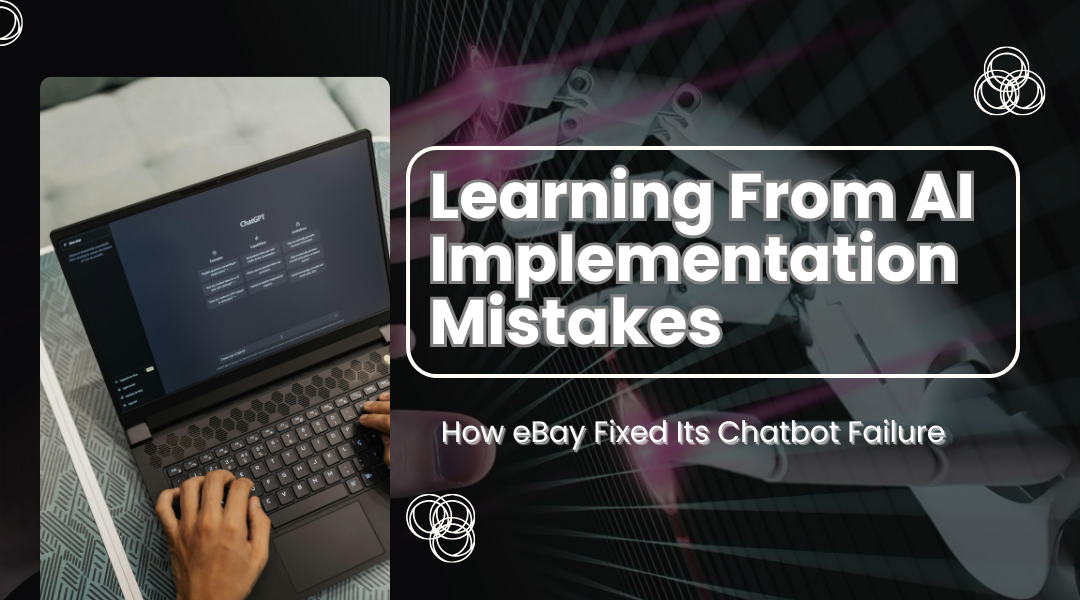When companies rush into artificial intelligence projects without proper planning, they often learn tough lessons the hard way. eBay’s journey with its ShopBot chatbot offers valuable insights for any business considering AI solutions.
What Went Wrong With eBay’s AI Assistant
In 2016, eBay launched ShopBot – an AI-powered shopping assistant designed to help customers find products through natural conversation. The ambitious project initially disappointed users with:
- Confusing responses to simple questions
- Generic product recommendations that missed the mark
- Frequent misunderstandings of customer requests
Root Causes of Failure:
- Limited Training Data
- The AI only understood basic queries about common products
- Couldn’t handle niche items or complex shopping needs
- No Clear Success Metrics
- Launched without targets for accuracy or customer satisfaction
- No way to measure if the bot was actually helping shoppers
- Lack of Real-World Testing
- Deployed to all users without small-scale trials
- Missed obvious flaws that proper testing would have revealed
How eBay Turned Things Around
The company made several crucial improvements that transformed ShopBot from a liability to an asset:
1. Expanded the AI’s Knowledge Base
- Added millions of product listings across all categories
- Incorporated international shopping queries in multiple languages
- Hired human reviewers to label and clean training data
2. Established Performance Targets
- Set 90% accuracy benchmark for responses
- Aimed for 30% faster resolution times
- Tracked customer satisfaction scores monthly
3. Implemented Continuous Learning
- Created feedback loops from real customer interactions
- Partnered with IBM Watson to enhance the AI’s capabilities
- Launched controlled beta tests before wide releases
The Results of eBay’s Course Correction
After 18 months of improvements, ShopBot delivered:
- Response accuracy jumped from 70% to 92%
- Customer satisfaction increased by 25 percentage points
- 15% more users engaged with the chatbot regularly
- Significant reduction in human support costs
Key Lessons for AI Implementation
1. Quality Data is Essential
- Example: When Spotify launched its AI DJ feature, it trained the system on decades of music history and listener behavior patterns
2. Define Success Before Launch
- Example: Duolingo’s AI tutors have strict accuracy targets for language corrections
3. Start Small and Scale Gradually
- Example: Bank of America tested its Erica chatbot with employees for months before customer rollout
4. Plan for Ongoing Improvements
- Example: Amazon’s Alexa team updates the AI weekly based on user interactions
Avoiding Common AI Project Pitfalls
Many organizations stumble into these traps when implementing AI:
- Departmental Silos
- Fix: Create cross-functional teams combining IT, customer service, and business units
- Unrealistic Timelines
- Fix: Build in extra months for testing and refinement
- Neglecting User Experience
- Fix: Conduct usability studies before finalizing designs
The Path Forward for AI Adoption
Successful AI implementation requires:
- Honest assessment of organizational readiness
- Willingness to learn from early mistakes
- Commitment to continuous improvement
- Balanced expectations about capabilities
As eBay’s experience proves, initial failures can become valuable stepping stones when companies take time to analyze problems and make thoughtful corrections. The most effective AI solutions emerge from this process of testing, learning, and refining over time.
For businesses considering AI tools, the key is viewing early setbacks not as roadblocks but as necessary lessons on the path to creating truly helpful automated systems. With proper planning and patience, organizations can develop AI assistants that actually enhance rather than frustrate the user experience.
